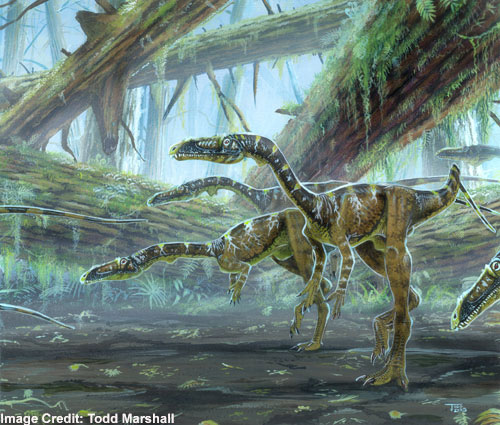
A dinosaur species long accused of cannibalism and infanticide is finally having the charges against it dropped and its reputation restored.
Researchers re-examining the anatomy of a Coelophysis fossil at the American Museum of Natural History (AMNH) found that bones in the rib-cage of the small upright dinosaur are not of its own kind, but of a primitive crocodile.
In a separate example, it was shown that the remains of a juvenile Coelophysis were actually located outside of another adult. The adult dinosaur probably crushed the juvenile when it died, the researchers say, and when the flesh decayed, the overlapping bones created the illusion that one dinosaur ate the other.
"Our research shows that the evidence for cannibalism in Coelophysis is non-existent," said study team member Sterling Nesbitt of the AMNH and Columbia University's Lamont-Doherty Earth Observatory in New York.
The findings, detailed in the current issue of the journal Biology Letters, also raise new questions about just how widespread cannibalism really was among theropods, the group of dinosaurs that eventually evolved into birds and to which Coelophysis belongs.
The two specimens studied were excavated from a mass grave containing hundreds of Coelophysis skeletons in New Mexico in 1947. When it was discovered that some of the fossils appeared to contain small reptile bones inside them, the late AMNH paleontologist Edwin Colbert—a distinguished dinosaur expert at the time—thought they resembled the remains of a young Coelophysis. The myth of the cannibal dinosaur was born.
More than 50 years later, researchers decided to re-examine the fossils behind Coelophysis' infamous reputation.
Get the world’s most fascinating discoveries delivered straight to your inbox.
"Cannibalism is seen among carnivorous animals today, but isn't common in living dinosaurs—birds. The behavior is really only prevalent among colonial sea birds and birds of prey," said fellow team member Alan Turner of AMNH. "This made us wonder just how widespread cannibalism was among non-avian dinosaurs, and the case for Coelophysis was the strongest."
The team also looked at the few other cases of cannibalism in Coleophysis and concluded they were based on indirect evidence—such as digested material and intestinal casts—that was too thin to build any real case on.
Claims of cannibalism have also been levied against two other theropods, Tyrannosaurus rex and Majungatholus atopus. Bones from both dinosaur species have been found with bite marks and teeth from what appear to be their own kind.
However, there are at least two species of tyrannosaurs in the region where the cannibalized bones were discovered, so it could be that they were eating closely related species, and not each other, the researchers say.


